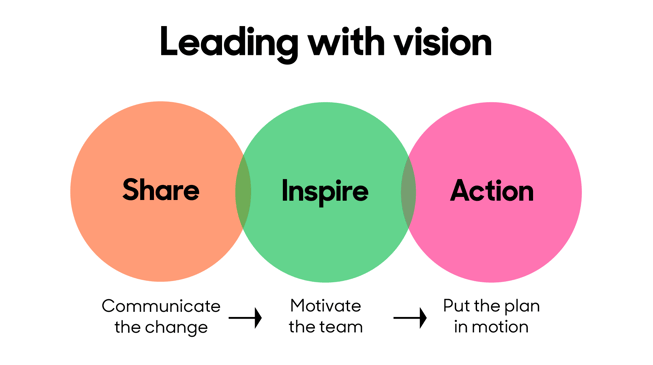Get in touch: nick.mayhew@alembicstrategy.com
Visionary leaders are typically fairly simple to spot. They’re the ones that tend to be the most visible, perhaps audible too, drawing attention to themselves as a result of their more obvious confidence and natural charisma. If you were asked to think of three visionary leaders in ten seconds, you’d likely come up with the CEO’s of vast, modern, global enterprises that now span the globe. But why did these particular leaders spring to mind?

Much can be attributed to the rapid evolution of technology in today’s world, but what is it about these figures that loads them into your mind so quickly? There are literally thousands of them out there to choose from. I’ll answer this question shortly, but before we get to that, let’s look at what makes great visionary leaders so notable, and explore why they display certain qualities that are not obvious in other leaders.
What is a visionary leader?
In addition to being highly personable and possessing a somewhat magnetic charm, great visionary leaders can be identified by a number of qualities that set them apart from others. These characteristics are typically:
- Able to spot trends at a distance
- Knowing how to adapt and play to those trends
- Creating a plan to achieve their ambition
- Enlisting the assistance of others in pursuit of their vision
1. The ability to spot changing business trends
A visionary leader has the ability to be able to see changes in the environment from long range. The skill of being able to spot and track a shift in trade, new market forces or evolving practices gives these leaders the time to adapt and change course to suit the incoming change. This particular ability stems from the possession of a heightened sense of awareness which helps visionary leaders tune in to those aspects of the modus operandi of the business which could be affected by the change.
2. Adapting to changing business trends
With the ability to identify change, visionary leaders are not only better equipped to adapt to change as they now only have additional time in which to do so, but they are more experienced in knowing how to react and move forward. Coupled with the ability to identify change, and with a seemingly in-built mechanism to shift gear and match the new market forces, these leaders are adept at synchronising their operations to match change.
3. Developing strategies to achieve objectives
Armed with knowledge around future trends and the ability to adapt to the change presented by them, visionary leaders know how to create strategic plans to achieve their ambition. A robust strategy, formed in advance of competition doing so, that clearly articulates the objectives of the leadership team will precisely state those activities that must be carried out in order to accomplish the business aims. This can have a significant and positive effect of turbo-charging the workforce.
4. Enrolling the wider team
Of course, leaders can’t do it all on their own, and a vision and a strategy in isolation are simply not enough to initiate change. Leaders need the help of others. If you’re fortunate enough to work alongside a visionary leader - or if you are, in fact, one yourself(!) - then you’ll be fully aware of how these individuals can energise a team. The ability to motivate a team so that they are willing to support a leader 100% is an incredibly difficult, but essential skill to master.
Whilst this is a somewhat granular view of the characteristics of visionary leaders, it is nevertheless typical and largely applicable to many of the great visionary leaders. However, there is another, overarching characteristic that is a common trait displayed by the CEO’s and MD’s of organisations that have accomplished significant change or innovation - they all possess the ability to inspire, mobilise and guide their staff in a way which others struggle to do.
Working towards business vision
 It is this soft but significant skill that sets truly great leaders apart from the pack, making them incredibly valuable in organisations where change or innovation is a strategic business objective. Particularly challenging transitions require the ability of a leader with broad people skills and organisational expertise blended with the steadfast ability to hold on to the vision, or end state. And, of course, knowing how to inspire teams to stack up and get behind a leader so that they can propel the organisation as a whole towards the vision.
It is this soft but significant skill that sets truly great leaders apart from the pack, making them incredibly valuable in organisations where change or innovation is a strategic business objective. Particularly challenging transitions require the ability of a leader with broad people skills and organisational expertise blended with the steadfast ability to hold on to the vision, or end state. And, of course, knowing how to inspire teams to stack up and get behind a leader so that they can propel the organisation as a whole towards the vision.
The role of emotional intelligence
Have you ever noticed how some people are able to connect with you in a way which feels almost instantly comfortable? It’s almost as if you’ve known one another for a long time, despite having only just met. There’s a very good chance that you’ve clicked with this person because you share a passion for a common interest which ignites conversation and lowers barriers, or the other has such high emotional intelligence that they are architecting the encounter in a way which promotes free-flowing vocal exchange under the premise of trust and understanding.
Great visionary leaders often possess this ability in abundance. Emotional intelligence stems from heightened self-awareness and allows you to display empathy with people in a way which others might struggle with. In being able to read the signs displayed by people that you speak to, it is possible to engage with them in a way which is more meaningful, inspiring greater connection and trust via an empathetic approach.
Conclusion
The process of sharing, inspiring and actioning is the key difference between organisations that succeed over those that fail. The driver behind both is the leader, and it is the skill set of the leader coupled with their ability to drive strategy through that differentiates one from the other. This is what makes a leader visionary rather than simply a leader.
The diagram here illustrates a process that can be used as a framework for leaders to articulate, motivate and initiate their strategic plans.

Leading with vision
So, back to the question asked at the start of this article - why do you automatically think of leaders of the biggest, seemingly most successful firms when you consider visionary leaders? It’s likely because they have a level of emotional intelligence that has caught your attention and touched you in a way that other leaders don’t. And it’s very simple to think of leaders who don’t have that emotional intelligence and connect with us, but we won’t go there in this piece!





